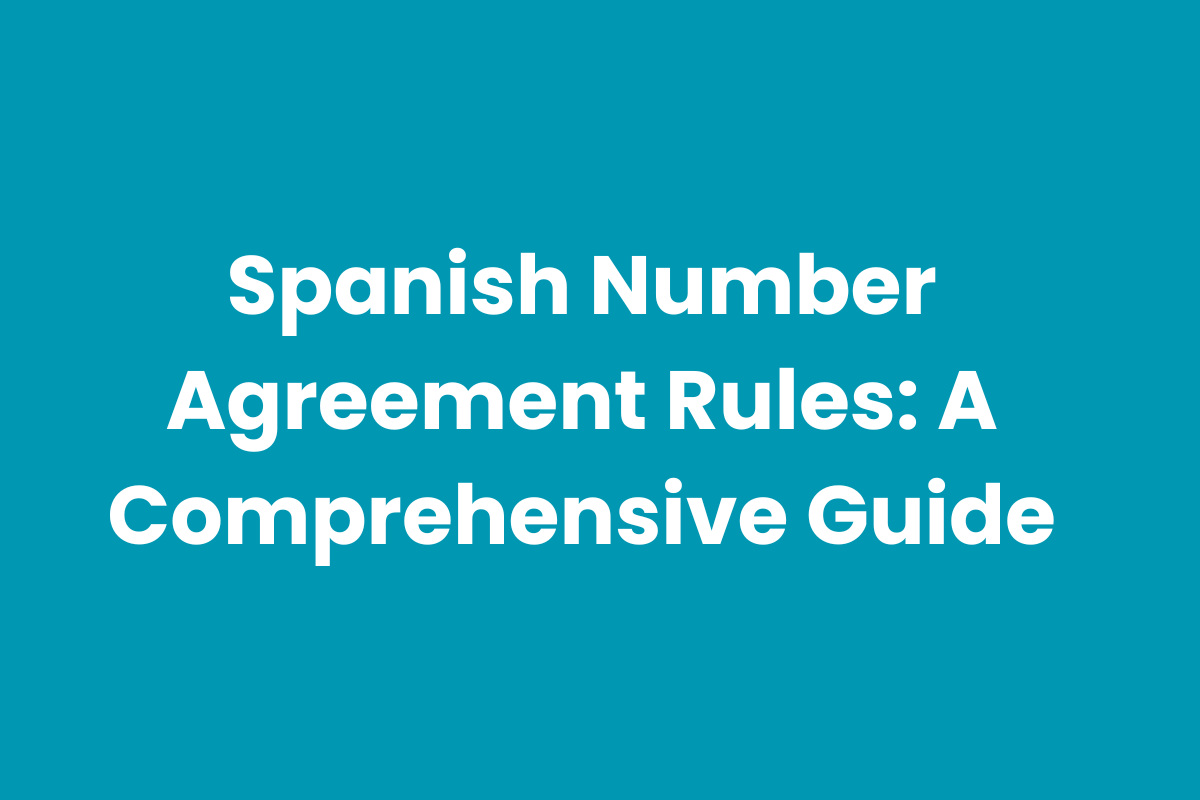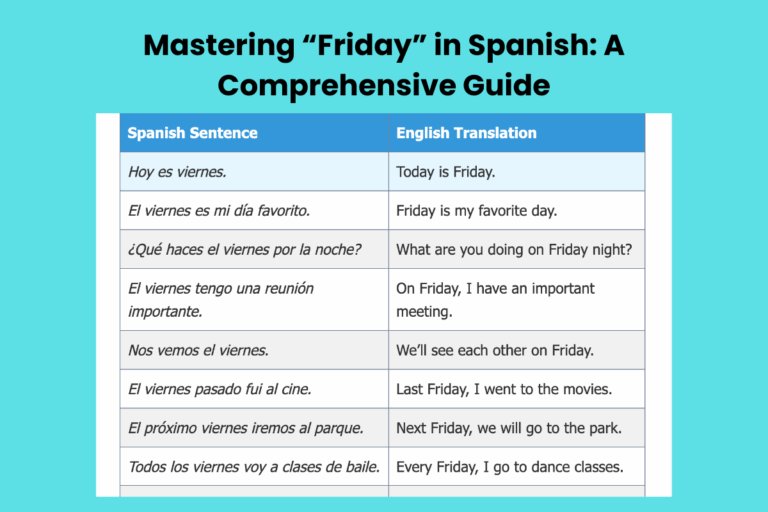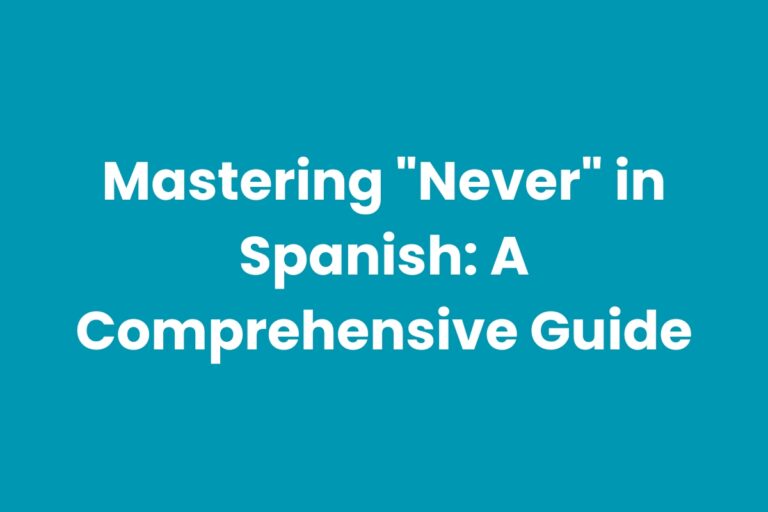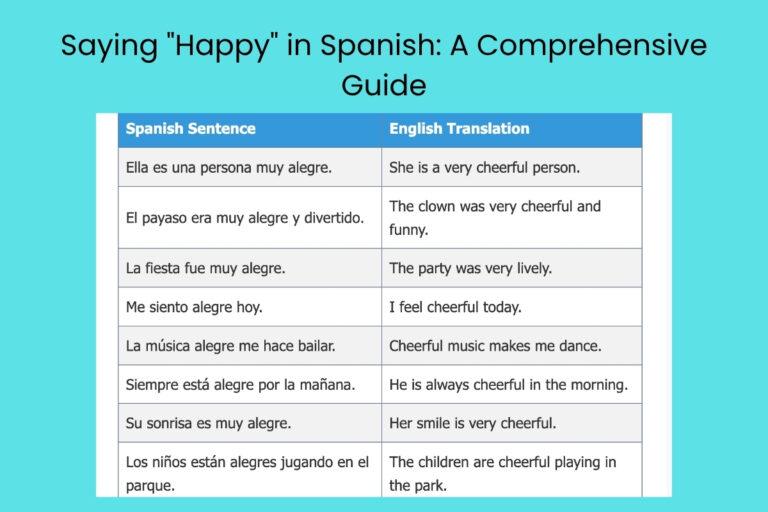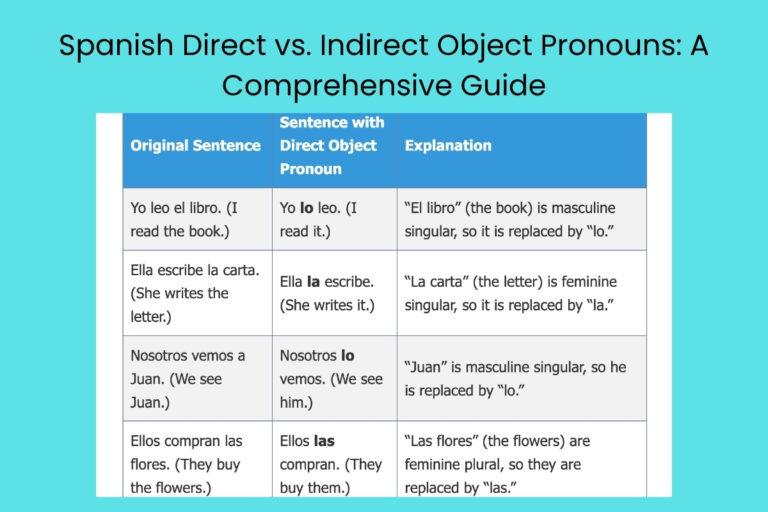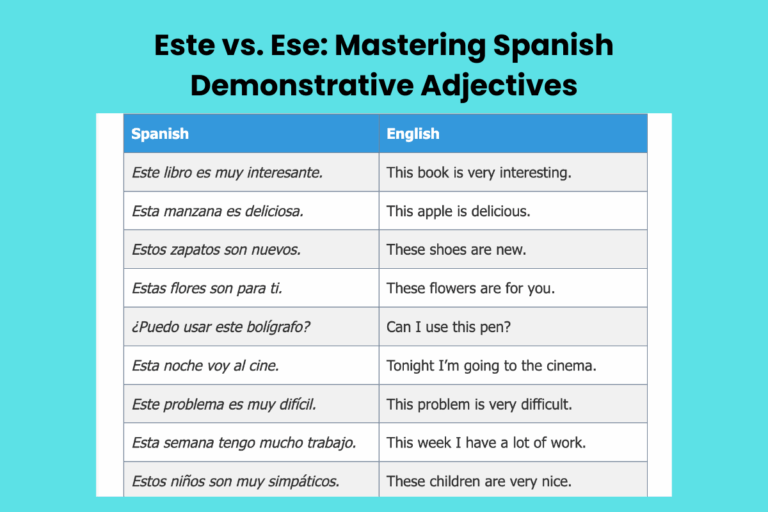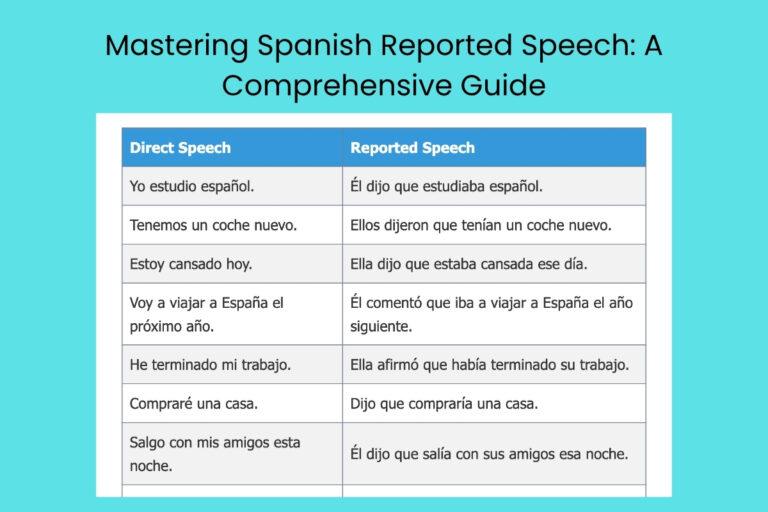Spanish Number Agreement Rules: A Comprehensive Guide
Mastering number agreement in Spanish is crucial for clear and accurate communication. Number agreement, or concordancia de número, ensures that nouns, adjectives, articles, and pronouns correctly align in number (singular or plural). This grammatical concept is fundamental to constructing grammatically sound sentences and avoiding common errors that can lead to miscommunication. This guide provides a detailed exploration of number agreement rules in Spanish, offering comprehensive explanations, examples, and practice exercises. This article is designed for Spanish learners of all levels, from beginners seeking to establish a strong foundation to advanced students aiming to refine their grammatical accuracy. By understanding and applying these rules, learners can significantly improve their fluency and confidence in Spanish.
Table of Contents
- Definition of Number Agreement in Spanish
- Structural Breakdown of Number Agreement
- Number Agreement with Nouns
- Number Agreement with Articles
- Number Agreement with Adjectives
- Number Agreement with Pronouns
- Examples of Number Agreement
- Usage Rules for Number Agreement
- Common Mistakes in Number Agreement
- Practice Exercises
- Advanced Topics in Number Agreement
- Frequently Asked Questions (FAQ)
- Conclusion
Definition of Number Agreement in Spanish
Number agreement, known as concordancia de número in Spanish, is a fundamental grammatical concept that dictates the consistency in number between different parts of a sentence. Specifically, it refers to the requirement that nouns, articles, adjectives, and pronouns must agree in number, meaning they must all be either singular or plural. This agreement ensures that the sentence is grammatically correct and conveys the intended meaning clearly. Without proper number agreement, sentences can sound awkward, confusing, or even incorrect to native Spanish speakers. Understanding and applying these rules is essential for effective communication in Spanish.
The primary function of number agreement is to maintain grammatical coherence within a sentence. It helps listeners and readers understand the relationships between different elements and avoids ambiguity.
For example, if you are describing multiple objects, the adjective and article must also be in the plural form to correctly indicate that you are referring to more than one item. Number agreement is relevant in virtually all contexts where Spanish is used, from casual conversations to formal writing.
Mastering this concept is a cornerstone of Spanish grammar proficiency.
Structural Breakdown of Number Agreement
The structural breakdown of number agreement in Spanish involves understanding how nouns, articles, adjectives, and pronouns interact to maintain grammatical consistency. The core principle is that all these elements must agree in number (singular or plural).
Let’s break down each component:
- Nouns: Nouns are the foundation. They can be singular (referring to one item) or plural (referring to multiple items). The form of the noun influences the form of other words that modify it.
- Articles: Articles (el, la, los, las, un, una, unos, unas) precede nouns and indicate whether the noun is specific (definite) or non-specific (indefinite). They must agree in number with the noun.
- Adjectives: Adjectives describe nouns and must also agree in number. They typically follow the noun they modify, although there are exceptions.
- Pronouns: Pronouns replace nouns and must agree in number with the noun they are replacing. This is particularly important with subject pronouns (yo, tú, él, ella, nosotros, vosotros, ellos, ellas) and object pronouns (me, te, lo, la, nos, os, los, las).
The basic pattern is: [Article] + Noun + Adjective. Each of these elements needs to be in the same number. For example: el libro interesante (the interesting book – singular) vs. los libros interesantes (the interesting books – plural).
Number Agreement with Nouns
Formation of Plural Nouns
Forming plural nouns in Spanish generally follows straightforward rules. The most common rules are:
- Rule 1: If the noun ends in a vowel, add -s. For example, libro (book) becomes libros (books).
- Rule 2: If the noun ends in a consonant, add -es. For example, árbol (tree) becomes árboles (trees).
- Rule 3: If the noun ends in -z, change the -z to -c and add -es. For example, lápiz (pencil) becomes lápices (pencils).
- Rule 4: Nouns ending in -ión often add -es, and the accent mark may shift. For example, canción (song) becomes canciones (songs).
These rules cover the majority of nouns. However, there are some exceptions and irregularities, which are discussed below.
Exceptions to Plural Noun Formation
While the rules above are generally reliable, some nouns have irregular plural forms. Here are some notable exceptions:
- Nouns ending in -s or -x: If the noun is stressed on the last syllable, add -es. If not, the noun remains the same in both singular and plural. Examples: el autobús (the bus), los autobuses (the buses); el tórax (the thorax), los tórax (the thoraxes). But, el paraguas (the umbrella), los paraguas (the umbrellas).
- Foreign words: Some foreign words retain their original pluralization rules or are adapted to Spanish rules. For example, el software (the software), los softwares (the softwares) or el software (the software), los software (the software).
- Compound nouns: The pluralization of compound nouns can vary. Generally, if the compound noun is written as one word, it follows regular pluralization rules. If it is written as separate words, only the first noun is pluralized. Examples: el paraguas (the umbrella), los paraguas (the umbrellas); el hombre rana (the frogman), los hombres rana (the frogmen).
Number Agreement with Articles
Articles in Spanish are crucial for indicating whether a noun is specific or non-specific, and they must agree in number with the noun they modify. There are two types of articles: definite and indefinite.
Definite Articles
Definite articles (el, la, los, las) refer to specific nouns. Their number agreement is as follows:
- El: Singular, masculine (e.g., el libro – the book)
- La: Singular, feminine (e.g., la casa – the house)
- Los: Plural, masculine (e.g., los libros – the books)
- Las: Plural, feminine (e.g., las casas – the houses)
The correct definite article must match both the gender and number of the noun.
Indefinite Articles
Indefinite articles (un, una, unos, unas) refer to non-specific nouns. Their number agreement is as follows:
- Un: Singular, masculine (e.g., un libro – a book)
- Una: Singular, feminine (e.g., una casa – a house)
- Unos: Plural, masculine (e.g., unos libros – some books)
- Unas: Plural, feminine (e.g., unas casas – some houses)
Like definite articles, indefinite articles must agree in both gender and number with the noun they modify. Note that unos and unas can also mean “approximately” or “about” in addition to “some.”
Number Agreement with Adjectives
Adjectives in Spanish describe nouns and must agree with them in both gender and number. This means that if a noun is singular and masculine, the adjective must also be singular and masculine.
If the noun is plural and feminine, the adjective must also be plural and feminine.
Adjective Placement
In Spanish, adjectives generally follow the noun they modify. For example:
- El libro rojo (the red book)
- La casa blanca (the white house)
- Los libros rojos (the red books)
- Las casas blancas (the white houses)
However, some adjectives precede the noun, especially those that describe inherent qualities or express subjective opinions. For example:
- Un buen amigo (a good friend)
- Una bella mujer (a beautiful woman)
Regardless of their placement, adjectives must always agree in number and gender with the noun they modify.
Adjective Exceptions
Some adjectives do not change form to indicate gender but still must agree in number. These adjectives typically end in -e or -ista. For example:
- El estudiante inteligente (the intelligent student)
- La estudiante inteligente (the intelligent student)
- Los estudiantes inteligentes (the intelligent students)
- Las estudiantes inteligentes (the intelligent students)
Adjectives of nationality typically follow the standard agreement rules. For example:
- El chico español (the Spanish boy)
- La chica española (the Spanish girl)
- Los chicos españoles (the Spanish boys)
- Las chicas españolas (the Spanish girls)
Number Agreement with Pronouns
Pronouns replace nouns and must agree with them in number (and gender, where applicable). This agreement ensures that the reference is clear and unambiguous.
Subject Pronouns
Subject pronouns (yo, tú, él, ella, nosotros, vosotros, ellos, ellas) indicate who is performing the action of the verb. Their number agreement is as follows:
- Singular: yo (I), tú (you, informal), él (he), ella (she), usted (you, formal)
- Plural: nosotros/nosotras (we), vosotros/vosotras (you, informal plural), ellos/ellas (they), ustedes (you, formal plural)
The verb conjugation must also agree with the subject pronoun. For example:
- Yo hablo español (I speak Spanish)
- Ellos hablan español (They speak Spanish)
Object Pronouns
Object pronouns (me, te, lo, la, nos, os, los, las) replace the direct or indirect object of a verb. Their number and gender agreement is as follows:
- Singular, masculine: lo (him, it)
- Singular, feminine: la (her, it)
- Plural, masculine: los (them)
- Plural, feminine: las (them)
For example:
- Veo el libro. Lo veo. (I see the book. I see it.)
- Veo las casas. Las veo. (I see the houses. I see them.)
Examples of Number Agreement
Here are several examples illustrating number agreement in various contexts. These examples cover nouns, articles, adjectives, and pronouns, showcasing how they work together to create grammatically correct sentences.
Noun and Article Agreement
This table illustrates the agreement between nouns and articles in both singular and plural forms.
| Singular (Masculine) | Plural (Masculine) | Singular (Feminine) | Plural (Feminine) |
|---|---|---|---|
| El libro (The book) | Los libros (The books) | La casa (The house) | Las casas (The houses) |
| Un perro (A dog) | Unos perros (Some dogs) | Una gata (A cat) | Unas gatas (Some cats) |
| El coche (The car) | Los coches (The cars) | La flor (The flower) | Las flores (The flowers) |
| El árbol (The tree) | Los árboles (The trees) | La mesa (The table) | Las mesas (The tables) |
| El reloj (The clock) | Los relojes (The clocks) | La silla (The chair) | Las sillas (The chairs) |
| El papel (The paper) | Los papeles (The papers) | La ventana (The window) | Las ventanas (The windows) |
| El teléfono (The telephone) | Los teléfonos (The telephones) | La puerta (The door) | Las puertas (The doors) |
| El ordenador (The computer) | Los ordenadores (The computers) | La lámpara (The lamp) | Las lámparas (The lamps) |
| El vaso (The glass) | Los vasos (The glasses) | La taza (The cup) | Las tazas (The cups) |
| El plato (The plate) | Los platos (The plates) | La cuchara (The spoon) | Las cucharas (The spoons) |
| El tenedor (The fork) | Los tenedores (The forks) | La servilleta (The napkin) | Las servilletas (The napkins) |
| El cuchillo (The knife) | Los cuchillos (The knives) | La pared (The wall) | Las paredes (The walls) |
| El cuadro (The painting) | Los cuadros (The paintings) | La cortina (The curtain) | Las cortinas (The curtains) |
| El espejo (The mirror) | Los espejos (The mirrors) | La alfombra (The rug) | Las alfombras (The rugs) |
| El sofá (The sofa) | Los sofás (The sofas) | La almohada (The pillow) | Las almohadas (The pillows) |
| El cojín (The cushion) | Los cojines (The cushions) | La manta (The blanket) | Las mantas (The blankets) |
| El estante (The shelf) | Los estantes (The shelves) | La revista (The magazine) | Las revistas (The magazines) |
| El periódico (The newspaper) | Los periódicos (The newspapers) | La carta (The letter) | Las cartas (The letters) |
| El sobre (The envelope) | Los sobres (The envelopes) | La llave (The key) | Las llaves (The keys) |
| El candado (The padlock) | Los candados (The padlocks) | La cerradura (The lock) | Las cerraduras (The locks) |
Noun and Adjective Agreement
This table shows how adjectives agree in number with the nouns they modify.
| Singular (Masculine) | Plural (Masculine) | Singular (Feminine) | Plural (Feminine) |
|---|---|---|---|
| El libro interesante (The interesting book) | Los libros interesantes (The interesting books) | La casa interesante (The interesting house) | Las casas interesantes (The interesting houses) |
| Un perro pequeño (A small dog) | Unos perros pequeños (Some small dogs) | Una gata pequeña (A small cat) | Unas gatas pequeñas (Some small cats) |
| El coche rápido (The fast car) | Los coches rápidos (The fast cars) | La flor roja (The red flower) | Las flores rojas (The red flowers) |
| El hombre alto (The tall man) | Los hombres altos (The tall men) | La mujer alta (The tall woman) | Las mujeres altas (The tall women) |
| El día soleado (The sunny day) | Los días soleados (The sunny days) | La noche oscura (The dark night) | Las noches oscuras (The dark nights) |
| El trabajo difícil (The difficult job) | Los trabajos difíciles (The difficult jobs) | La tarea difícil (The difficult task) | Las tareas difíciles (The difficult tasks) |
| El examen fácil (The easy exam) | Los exámenes fáciles (The easy exams) | La prueba fácil (The easy test) | Las pruebas fáciles (The easy tests) |
| El problema complicado (The complicated problem) | Los problemas complicados (The complicated problems) | La situación complicada (The complicated situation) | Las situaciones complicadas (The complicated situations) |
| El ejercicio útil (The useful exercise) | Los ejercicios útiles (The useful exercises) | La herramienta útil (The useful tool) | Las herramientas útiles (The useful tools) |
| El mensaje importante (The important message) | Los mensajes importantes (The important messages) | La noticia importante (The important news) | Las noticias importantes (The important news) |
| El parque verde (The green park) | Los parques verdes (The green parks) | La hierba verde (The green grass) | Las hierbas verdes (The green grasses) |
| El cielo azul (The blue sky) | Los cielos azules (The blue skies) | La nube azul (The blue cloud) | Las nubes azules (The blue clouds) |
| El café caliente (The hot coffee) | Los cafés calientes (The hot coffees) | La sopa caliente (The hot soup) | Las sopas calientes (The hot soups) |
| El té frío (The cold tea) | Los tés fríos (The cold teas) | La limonada fría (The cold lemonade) | Las limonadas frías (The cold lemonades) |
| El pan fresco (The fresh bread) | Los panes frescos (The fresh breads) | La fruta fresca (The fresh fruit) | Las frutas frescas (The fresh fruits) |
| El vino bueno (The good wine) | Los vinos buenos (The good wines) | La cerveza buena (The good beer) | Las cervezas buenas (The good beers) |
| El libro viejo (The old book) | Los libros viejos (The old books) | La casa vieja (The old house) | Las casas viejas (The old houses) |
| El coche nuevo (The new car) | Los coches nuevos (The new cars) | La bicicleta nueva (The new bicycle) | Las bicicletas nuevas (The new bicycles) |
| El amigo sincero (The sincere friend) | Los amigos sinceros (The sincere friends) | La amiga sincera (The sincere friend) | Las amigas sinceras (The sincere friends) |
| El estudiante aplicado (The diligent student) | Los estudiantes aplicados (The diligent students) | La estudiante aplicada (The diligent student) | Las estudiantes aplicadas (The diligent students) |
Noun, Article, and Adjective Agreement
This table provides examples of complete phrases where nouns, articles, and adjectives all agree in number and gender.
| Singular (Masculine) | Plural (Masculine) | Singular (Feminine) | Plural (Feminine) |
|---|---|---|---|
| El libro rojo interesante (The interesting red book) | Los libros rojos interesantes (The interesting red books) | La casa blanca grande (The big white house) | Las casas blancas grandes (The big white houses) |
| Un perro pequeño juguetón (A small playful dog) | Unos perros pequeños juguetones (Some small playful dogs) | Una gata negra elegante (A black elegant cat) | Unas gatas negras elegantes (Some black elegant cats) |
| El coche nuevo rápido (The fast new car) | Los coches nuevos rápidos (The fast new cars) | La flor amarilla hermosa (The beautiful yellow flower) | Las flores amarillas hermosas (The beautiful yellow flowers) |
| El hombre alto simpático (The tall friendly man) | Los hombres altos simpáticos (The tall friendly men) | La mujer alta inteligente (The tall intelligent woman) | Las mujeres altas inteligentes (The tall intelligent women) |
| El día soleado perfecto (The perfect sunny day) | Los días soleados perfectos (The perfect sunny days) | La noche oscura misteriosa (The mysterious dark night) | Las noches oscuras misteriosas (The mysterious dark nights) |
| El trabajo difícil importante (The important difficult job) | Los trabajos difíciles importantes (The important difficult jobs) | La tarea difícil complicada (The complicated difficult task) | Las tareas difíciles complicadas (The complicated difficult tasks) |
| El examen fácil rápido (The quick easy exam) | Los exámenes fáciles rápidos (The quick easy exams) | La prueba fácil sencilla (The simple easy test) | Las pruebas fáciles sencillas (The simple easy tests) |
| El problema complicado serio (The serious complicated problem) | Los problemas complicados serios (The serious complicated problems) | La situación complicada delicada (The delicate complicated situation) | Las situaciones complicadas delicadas (The delicate complicated situations) |
| El ejercicio útil práctico (The practical useful exercise) | Los ejercicios útiles prácticos (The practical useful exercises) | La herramienta útil versátil (The versatile useful tool) | Las herramientas útiles versátiles (The versatile useful tools) |
| El mensaje importante urgente (The urgent important message) | Los mensajes importantes urgentes (The urgent important messages) | La noticia importante reciente (The recent important news) | Las noticias importantes recientes (The recent important news) |
| El parque verde grande (The large green park) | Los parques verdes grandes (The large green parks) | La hierba verde fresca (The fresh green grass) | Las hierbas verdes frescas (The fresh green grasses) |
| El cielo azul claro (The clear blue sky) | Los cielos azules claros (The clear blue skies) | La nube azul ligera (The light blue cloud) | Las nubes azules ligeras (The light blue clouds) |
| El café caliente delicioso (The delicious hot coffee) | Los cafés calientes deliciosos (The delicious hot coffees) | La sopa caliente sabrosa (The tasty hot soup) | Las sopas calientes sabrosas (The tasty hot soups) |
| El té frío refrescante (The refreshing cold tea) | Los tés fríos refrescantes (The refreshing cold teas) | La limonada fría dulce (The sweet cold lemonade) | Las limonadas frías dulces (The sweet cold lemonades) |
| El pan fresco crujiente (The crispy fresh bread) | Los panes frescos crujientes (The crispy fresh breads) | La fruta fresca jugosa (The juicy fresh fruit) | Las frutas frescas jugosas (The juicy fresh fruits) |
| El vino bueno caro (The expensive good wine) | Los vinos buenos caros (The expensive good wines) | La cerveza buena artesanal (The artisanal good beer) | Las cervezas buenas artesanales (The artisanal good beers) |
| El libro viejo interesante (The interesting old book) | Los libros viejos interesantes (The interesting old books) | La casa vieja abandonada (The abandoned old house) | Las casas viejas abandonadas (The abandoned old houses) |
| El coche nuevo elegante (The elegant new car) | Los coches nuevos elegantes (The elegant new cars) | La bicicleta nueva cómoda (The comfortable new bicycle) | Las bicicletas nuevas cómodas (The comfortable new bicycles) |
| El amigo sincero leal (The loyal sincere friend) | Los amigos sinceros leales (The loyal sincere friends) | La amiga sincera comprensiva (The understanding sincere friend) | Las amigas sinceras comprensivas (The understanding sincere friends) |
| El estudiante aplicado inteligente (The intelligent diligent student) | Los estudiantes aplicados inteligentes (The intelligent diligent students) | La estudiante aplicada responsable (The responsible diligent student) | Las estudiantes aplicadas responsables (The responsible diligent students) |
Pronoun Agreement
These examples demonstrate how pronouns agree in number with the nouns they replace.
| Sentence with Noun | Sentence with Pronoun |
|---|---|
| Juan es alto. Juan es inteligente. (Juan is tall. Juan is intelligent.) | Juan es alto. Él es inteligente. (Juan is tall. He is intelligent.) |
| María es doctora. María trabaja en el hospital. (Maria is a doctor. Maria works in the hospital.) | María es doctora. Ella trabaja en el hospital. (Maria is a doctor. She works in the hospital.) |
| Los libros son interesantes. Los libros están en la mesa. (The books are interesting. The books are on the table.) | Los libros son interesantes. Ellos están en la mesa. (The books are interesting. They are on the table.) |
| Las casas son grandes. Las casas están cerca del río. (The houses are big. The houses are near the river.) | Las casas son grandes. Ellas están cerca del río. (The houses are big. They are near the river.) |
| Veo el libro. Quiero leer el libro. (I see the book. I want to read the book.) | Veo el libro. Lo quiero leer. (
I see the book. I want to read it.) |
| Compro las flores. Necesito las flores. (I buy the flowers. I need the flowers.) | Compro las flores. Las necesito. (I buy the flowers. I need them.) |
| Doy el regalo a Juan. Doy el regalo a Juan hoy. (I give the gift to Juan. I give the gift to Juan today.) | Doy el regalo a Juan. Le doy el regalo hoy. (I give the gift to Juan. I give it to him today.) |
| Doy las flores a María. Doy las flores a María mañana. (I give the flowers to Maria. I give the flowers to Maria tomorrow.) | Doy las flores a María. Le doy las flores mañana. (I give the flowers to Maria. I give them to her tomorrow.) |
| Hablo con mis amigos. Veo a mis amigos en el parque. (I talk with my friends. I see my friends in the park.) | Hablo con mis amigos. Los veo en el parque. (I talk with my friends. I see them in the park.) |
| Ayudo a mis amigas. Quiero ayudar a mis amigas. (I help my friends. I want to help my friends.) | Ayudo a mis amigas. Las quiero ayudar. (I help my friends. I want to help them.) |
| Visito a mi abuelo. Quiero visitar a mi abuelo. (I visit my grandfather. I want to visit my grandfather.) | Visito a mi abuelo. Lo quiero visitar. (I visit my grandfather. I want to visit him.) |
| Visito a mi abuela. Quiero visitar a mi abuela. (I visit my grandmother. I want to visit my grandmother.) | Visito a mi abuela. La quiero visitar. (I visit my grandmother. I want to visit her.) |
| Veo a Ana y Juan. Les doy un regalo. (I see Ana and Juan. I give them a gift.) | Veo a Ana y Juan. Les doy un regalo. (I see Ana and Juan. I give them a gift.) |
| Escribo a mis padres. Les envío una carta. (I write to my parents. I send them a letter.) | Escribo a mis padres. Les envío una carta. (I write to my parents. I send them a letter.) |
| Compro un libro para ti. Te doy el libro. (I buy a book for you. I give you the book.) | Compro un libro para ti. Te lo doy. (I buy a book for you. I give it to you.) |
| Compro unas flores para ti. Te doy las flores. (I buy some flowers for you. I give you the flowers.) | Compro unas flores para ti. Te las doy. (I buy some flowers for you. I give them to you.) |
Complex Sentence Agreement
These examples illustrate number agreement in more complex sentences, where multiple elements must agree.
- Los estudiantes inteligentes estudian mucho porque los exámenes difíciles requieren preparación. (The intelligent students study a lot because the difficult exams require preparation.)
- Las casas grandes y bonitas tienen jardines hermosos donde las flores coloridas crecen abundantemente. (The big and beautiful houses have beautiful gardens where the colorful flowers grow abundantly.)
- Yo compro los libros nuevos que tú recomiendas porque ellos son muy interesantes. (I buy the new books that you recommend because they are very interesting.)
- Nosotros visitamos a nuestros abuelos cada semana porque ellos nos dan consejos valiosos. (We visit our grandparents every week because they give us valuable advice.)
- Vosotros coméis las frutas frescas que compráis en el mercado porque ellas son muy saludables. (You eat the fresh fruits that you buy in the market because they are very healthy.)
- Ellos ven las películas antiguas que les gustan porque ellas les recuerdan su infancia. (They watch the old movies that they like because they remind them of their childhood.)
- Ellas leen los libros largos que encuentran en la biblioteca porque ellos son muy informativos. (They read the long books that they find in the library because they are very informative.)
- El profesor explica los temas complicados para que los estudiantes puedan entenderlos fácilmente. (The professor explains the complicated topics so that the students can understand them easily.)
- La madre cocina las comidas deliciosas para que los niños puedan comerlas con gusto. (The mother cooks the delicious meals so that the children can eat them with pleasure.)
- Los turistas visitan las ciudades históricas para que puedan aprender sobre su pasado interesante. (The tourists visit the historical cities so that they can learn about their interesting past.)
- Las amigas se ayudan mutuamente porque ellas saben que la amistad es muy importante. (The friends help each other because they know that friendship is very important.)
- Los hermanos se apoyan siempre porque ellos entienden que la familia es lo más valioso. (The siblings always support each other because they understand that family is the most valuable thing.)
- Yo estudio español porque quiero hablar con mis amigos que viven en España. Ellos me enseñan mucho. (I study Spanish because I want to talk with my friends who live in Spain. They teach me a lot.)
- Nosotros aprendemos sobre la cultura hispana porque queremos viajar a países donde la gente la valora. Ellos son muy amables. (We learn about the Hispanic culture because we want to travel to countries where people value it. They are very kind.)
Usage Rules for Number Agreement
Understanding the specific usage rules for number agreement is crucial for mastering Spanish grammar. These rules cover general principles, as well as specific cases such as compound nouns, collective nouns, and quantifiers.
General Agreement Rules
The general rules for number agreement are straightforward:
- Nouns and Articles: Articles must agree in number with the nouns they modify. Singular nouns take singular articles, and plural nouns take plural articles.
- Nouns and Adjectives: Adjectives must agree in number with the nouns they describe. Singular nouns are described by singular adjectives, and plural nouns are described by plural adjectives.
- Pronouns and Nouns: Pronouns must agree in number with the nouns they replace. Singular nouns are replaced by singular pronouns, and plural nouns are replaced by plural pronouns.
- Subject and Verb: The verb must agree in number with the subject. Singular subjects take singular verb forms, and plural subjects take plural verb forms.
These rules apply consistently across all types of sentences and are fundamental to grammatical correctness.
Agreement with Compound Nouns
Compound nouns can present unique challenges for number agreement. Here are some guidelines:
- Compound nouns written as one word: These follow regular pluralization rules. For example, el paraguas (the umbrella) becomes los paraguas (the umbrellas).
- Compound nouns written as separate words: Generally, only the first noun is pluralized, especially if the second noun modifies the first. For example, el hombre rana (the frogman) becomes los hombres rana (the frogmen). However, there can be exceptions depending on the specific compound noun.
- Compound nouns with prepositions: The noun that is being modified is the one that is pluralized. For example, el coche de carreras (the racing car) becomes los coches de carreras (the racing cars).
It’s important to learn the specific plural forms of common compound nouns to avoid errors.
Agreement with Collective Nouns
Collective nouns refer to a group of individuals or items. In Spanish, collective nouns are generally treated as singular, even though they refer to multiple entities.
- Singular Agreement: Collective nouns usually take singular verb forms and are modified by singular adjectives. For example, La gente es amable (The people are kind). Here, gente (people) is a collective noun and takes the singular verb form es.
- Exceptions: In some cases, if the focus is on the individual members of the group, a plural verb form may be used. However, this is less common and can sound awkward.
Understanding that collective nouns are typically treated as singular is essential for correct number agreement.
Agreement with Quantifiers
Quantifiers (words that indicate quantity) also affect number agreement. Common quantifiers include mucho, poco, bastante, demasiado, varios, algunos, ningunos (much, little, enough, too much, several, some, none).
- Agreement with Nouns: Quantifiers must agree in number and gender with the nouns they modify. For example, muchos libros (many books), pocas casas (few houses).
- Agreement with Verbs: When quantifiers are used as subjects, the verb must agree with the quantity being expressed. For example, Muchos estudiantes estudian (Many students study).
- Special Cases: Some quantifiers, like todo (all), can be tricky. Todo el libro (all the book – meaning the entire book) is singular, while Todos los libros (all the books) is plural.
Paying attention to the specific quantifier being used and its impact on the noun and verb is crucial for accurate number agreement.
Common Mistakes in Number Agreement
Even advanced learners of Spanish often make mistakes in number agreement. Being aware of these common errors can help you avoid them and improve your grammatical accuracy.
- Incorrect Article Usage: Using the wrong article (el instead of los, la instead of las) is a frequent mistake, especially when learners are unsure of a noun’s gender or number.
- Mismatched Adjectives: Failing to make adjectives agree in number with the nouns they modify is another common error. For example, saying el libro interesantes el libro interesantes instead of el libro interesante el libro interesante.
- Incorrect Pronoun Usage: Using the wrong pronoun to replace a noun, particularly with direct and indirect object pronouns, can lead to confusion.
- Verb Conjugation Errors: Not conjugating the verb correctly to agree with the subject is a common mistake, especially with irregular verbs.
- Confusion with Collective Nouns: Treating collective nouns as plural when they should be treated as singular (or vice versa) is a frequent error.
- Overgeneralization of Rules: Assuming that all nouns follow the standard pluralization rules without considering exceptions can lead to mistakes.
Regular practice and careful attention to detail are essential for avoiding these common mistakes.
Practice Exercises
To reinforce your understanding of number agreement, here are some practice exercises. These exercises cover noun-article agreement, noun-adjective agreement, and complete sentence agreement.
Exercise 1: Noun and Article Agreement
Fill in the blanks with the correct definite article (el, la, los, las) or indefinite article (un, una, unos, unas).
- ______ libro
- ______ casas
- ______ perro
- ______ flores
- ______ coche
- ______ mesa
- ______ árboles
- ______ silla
- ______ papel
- ______ ventana
Answers:
- El
- Las
- Un
- Unas
- El
- La
- Los
- Una
- El
- La
Exercise 2: Noun and Adjective Agreement
Complete the sentences by providing the correct form of the adjective in parentheses.
- El libro es ______ (interesante).
- Las casas son ______ (grande).
- Un perro ______ (pequeño) juega en el parque.
- Unas flores ______ (rojo) están en el jarrón.
- El coche es ______ (rápido).
- La mesa es ______ (blanco).
- Los árboles son ______ (alto).
- Una silla es ______ (cómodo).
- El papel es ______ (importante).
- La ventana es ______ (limpio).
Answers:
- interesante
- grandes
- pequeño
- rojas
- rápido
- blanca
- altos
- cómoda
- importante
- limpia
Exercise 3: Complete Sentence Agreement
Correct the following sentences to ensure number agreement.
- El libros es interesante. El libros es interesante.
- La casas es grande. La casas es grande.
- Un perros pequeño juega en el parque. Un perros pequeño juega en el parque.
- Un flores rojos están en el jarrón. Un flores rojos están en el jarrón.
- Los coche es rápidos. Los coche es rápidos.
Answers:
- El libro es interesante.
- Las casas son grandes.
- Un perro pequeño juega en el parque.
- Unas flores rojas están en el jarrón.
- Los coches son rápidos.
Advanced Topics in Number Agreement
Beyond the basic rules, there are advanced topics in number agreement that can further refine your understanding and accuracy in Spanish.
Agreement with Uncountable Nouns
Uncountable nouns (also known as mass nouns) refer to things that cannot be counted as individual units. Examples include agua (water), arena (sand), aire (air), and música (music). These nouns are generally used in the singular form.
- Singular Form: Uncountable nouns typically take singular articles and are described by singular adjectives. For example, El agua limpia (The clean water).
- Quantifying Uncountable Nouns: To express a specific quantity of an uncountable noun, you often use a unit of measurement. For example, un vaso de agua (a glass of water), dos kilos de arroz (two kilos of rice). In these cases, the verb agreement depends on the unit of measurement.
- Agreement with Verbs: When an uncountable noun is the subject, the verb is typically in the singular form. For example, La música es relajante (The music is relaxing).
Understanding how to use and modify uncountable nouns correctly is important for advanced Spanish proficiency.
Correct usage of impersonal verbs is crucial for making accurate and natural-sounding statements in Spanish.
Frequently Asked Questions (FAQ)
Here are some frequently asked questions about number agreement in Spanish, along with their answers.
Why is number agreement important in Spanish?
Number agreement is essential for grammatical correctness and clear communication. It ensures that all parts of a sentence are consistent, avoiding confusion and making it easier for listeners and readers to understand the intended meaning.
What are the most common mistakes learners make with number agreement?
Common mistakes include using the wrong articles, mismatched adjectives, incorrect pronoun usage, verb conjugation errors, confusion with collective nouns, and overgeneralization of pluralization rules.
How can I improve my number agreement skills?
Regular practice, careful attention to detail, and exposure to authentic Spanish content are key. Focus on understanding the rules, practicing with exercises, and seeking feedback on your writing and speaking.
Are there any resources that can help me practice number agreement?
Yes, there are many online resources, textbooks, and language learning apps that offer exercises and explanations on number agreement. Additionally, reading Spanish books, watching Spanish movies, and engaging in conversations with native speakers can provide valuable practice.
What should I do if I’m unsure about the correct number agreement in a sentence?
When in doubt, consult a grammar reference, use an online grammar checker, or ask a native speaker for clarification. Paying attention to the context and double-checking your work can also help you identify and correct errors.
Conclusion
Mastering number agreement in Spanish is a critical step toward achieving fluency and accuracy. By understanding the rules governing nouns, articles, adjectives, and pronouns, learners can construct grammatically sound sentences and communicate effectively.
This guide has provided a comprehensive overview of number agreement, including detailed explanations, examples, and practice exercises. Consistent effort and attention to detail will enable you to avoid common mistakes and refine your Spanish language skills.
Keep practicing, and you’ll find that number agreement becomes second nature, enhancing your confidence and fluency in Spanish.

